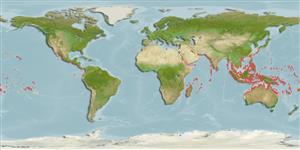Common names from other countries
Environment: milieu / climate zone / depth range / distribution range
Ecologia
; intervalo de profundidade 0 - 20 m (Ref. 81020). Tropical
Indo-West Pacific.
Length at first maturity / Tamanho / Peso / Idade
Maturity: Lm ? range ? - ? cm Max length : 35.0 cm TL macho/indeterminado; (Ref. 92930)
Found on sandy areas (Ref. 115900) surrounded by corals (Ref. 129602). During the day, this species is found under rubble on reef flats, while at night it starts being exposed and becoming active. Disturbance causes this species to eject copious amounts of Cuvierian tubules (Ref. 85218). Conveyor belt-feeder (Ref. 108108), meaning it ingests the substrate's surface and defecates on it (Ref. 115242). Inserts itself in cavities beneath coral colonies during the day along with other Holothuroids (Ref. 129602).
Life cycle and mating behavior
Maturidade | Reprodução | Desova | Ovos | Fecundidade | Larvas
Members of the class Holothuroidea are gonochoric and have only one gonad. Spawning and fertilization are both external and some exhibit brooding. Life cycle: Embryos develop into planktotrophic larvae (auricularia) then into doliolaria (barrel-shaped stage) which later metamorphose into juvenile sea cucumbers.
Hartati, S.T., I.S. Wahyuni and U.N. Badri. 2050. (Ref. 75656)
Categoria na Lista Vermelha da IUCN (Ref. 130435)
Categoria CITES (Ref. 108899)
Not Evaluated
Not Evaluated
Ameaça para o homem
Harmless
Utilização humana
Pescarias: espécies comerciais
| FishSource |
Ferramentas
Mais informação
Idade/TamanhoCrescimentoComprimento-pesoComprimento-comprimentoMorfologiaLarvasAbundância
Fontes da internet
Estimates based on models
Preferred temperature
(Ref.
115969): 25.6 - 29.3, mean 28.7 (based on 2707 cells).
